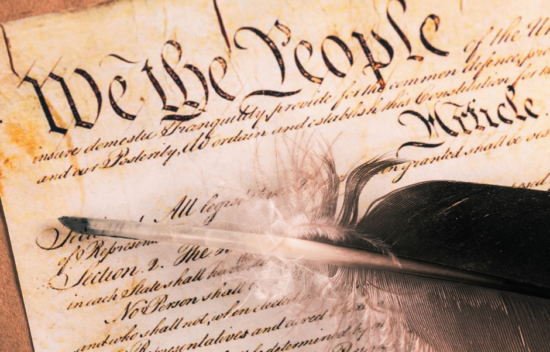
Founding Principles, Virtues, and the American Revolution
Guiding Question
- How were civic virtues demonstrated and Founding principles upheld during the lead-up to and during the American Revolution?
Objectives
- Students will understand the meaning of the principles of equality and natural rights by analyzing primary sources.
- Students will understand the virtues of moderation, respect, responsibility, courage, and prudence by analyzing primary sources.
Student Resources:
- Founding Principles, Civic Virtue, and the American Revolution Primary Source Set
- Founding Principles, Civic Virtue, and the American Revolution Graphic Organizer
Teacher Resources:
- Poster boards
- Sticky notes
Engage
Before class begins, write the following words and their definitions on the board. The first five are virtues and the last two are principles.
- Courage: The ability to take constructive action in the face of fear or danger; to stand firm as a person of character and do what is right, especially when it is unpopular or puts one at risk.
- Moderation: The avoidance of excess or extremes.
- Prudence: Practical wisdom that applies reason and other virtues to discern the right courses of action in specific situations.
- Responsibility: Acting on good judgment about what is right or wrong even when it is not popular. Individuals must take care of themselves, their families, and their fellow citizens/others in civil society and a republic and be vigilant to preserve their own liberty and the liberty of others.
- Respect: Regard for and defending the equal rights and inherent dignity of all human beings, including oneself.
- Natural/Inalienable Rights: Rights which belong to humans by nature and can only be justly abridged through due process. Examples are life, liberty, and property.
- Equality: All individuals have the same claim as human beings to natural rights and treatment under the law.
Lead a brief discussion on the principles and virtues. Answer any questions that students may have about each definition.
Explore
Divide students into seven groups and assign each one a principle or virtue.
In their groups, students should make a video, a collage on a poster board, or other visual in order to create a simple depiction of their word. Once finished, have students view others’ work in a gallery walk
- Gallery Walk:
- If the group visual displays were done on paper, groups rotate around the room, viewing other groups’ displays.
- Students use sticky notes to leave comments or questions on other groups’ work.
- Example: “I think ____ is important to me because…”
- If the visual displays were completed digitally, groups should review the other displays together on their devices.
- Have students use the comment feature on the chosen digital tool to interact with other groups by leaving comments or questions.
- If the group visual displays were done on paper, groups rotate around the room, viewing other groups’ displays.
Assess
Tell students “Now that we have a common understanding of these principles and virtues, let’s investigate some sources to see what evidence exists to answer our lesson guiding question: How were civic virtues demonstrated and Founding principles upheld in the Revolutionary era?”
Distribute the primary source readings and graphic organizer.
Scaffolding note: Depending on your class you can either have students read all the sources or read one source and then group up with other students in a jigsaw. For more information on the jig saw technique check out https://billofrightsinstitute.org/resources/modes-of-reading.
As students read, they should note the following in their graphic organizer:
- Environment: What is the environment like surrounding the creation of the document? What had happened before the document was created?
- Who: Who was the document created for? Was it written for a friend or foe in the form of a letter? Is it a diary entry that was probably just for individual memory keeping?
- Key details about personal experiences, including evidence of virtues or principles that are on the board. Note to students there may be more than one in each reading.
- Impact of the Principle/Virtue on events
Reflect & Extend
- Individual Reflection:
- Students write a short paragraph answering the question, “How were civic virtues demonstrated and Founding principles upheld in the Revolutionary era?”
- Class Discussion Questions:
- What challenges did you face when analyzing these primary sources?
- How did analyzing these primary sources help you better understand the broader context of the American Revolution?